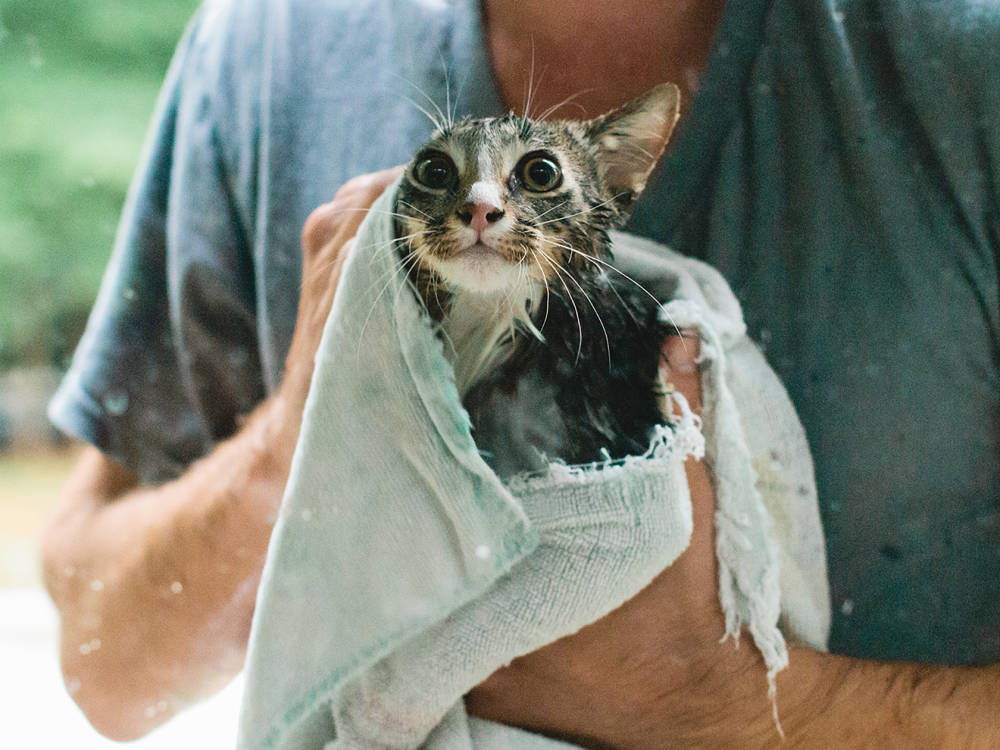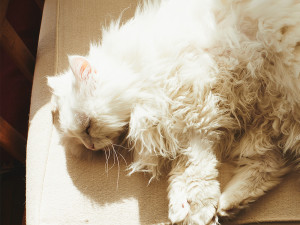
share article
Giving your cat a bath. It probably ranks up there on the difficulty level of folding a fitted sheet or sneezing with your eyes open. And why would you even want to do that — aren’t cats supposed to be self-cleaning? Technically, yes; that’s what that special barbed tongue is for. But according to Dr. Amy Onderdonk, DVM, there are a few good reasons to take matters into your own hands.
For one, your cat may at some point get into a mess that they can’t groom their way out of, like being sprayed by a skunk. But more commonly, a deep clean can curb shedding and the spread of allergens. “Most cats do not need bathing but there are exceptions,” explains Dr. Onderdonk. “For example, [hairless cats] tend to overproduce sebum and need routine baths. And on rare occasions we recommend bathing cats with dermatologic skin conditions with medicated shampoos, but not very often because cats famously dislike water. There are also people who are allergic to cats who bathe their pets weekly to reduce the dander on their coat.” If you find yourself in the odd predicament of needing to bathe your cat, you’ll need a strategy. This is it.
First, know that not all cats hate water
If you’ve never bathed a cat before, don’t overthink it. In some ways, washing a cat can be easier than washing a dog, mostly because they tend to be smaller and easier to contain. If you get in the habit of bathing your kitten regularly, they may be cool with it as they mature. And go figure, some cats actually like itopens in a new tab.
“It’s a rare cat who will take to bathing readily unless started early and gradually, but some cats love water!” says Dr. Onderdonk. “I had a client send me a video of her cat swimming in the bathtub. Because she started bathing him as a kitten, he grew to love the water and she allows him to do laps in her tub. Other cats are less interested in being immersed in the bathtub but are intrigued by moving water in the shower or dripping from the faucet. There is minimal risk involved in allowing a cat to play in water, but you would always want to start out with just a small amount of water in the tub and supervise.”
What you’ll need on hand
Not much. Just a moisturizing pet shampoo, washcloth, and towel. A sink is preferable to a tub and a sprayer attachment will make things easier, but you can also use a cup to pour water over your cat. What you could also use is a hand, so try to wrangle someone to help you hold them so they can’t escape mid-spa treatment. Before getting started, you might want to dim the lights, put on some soothing music, and light a lavender candle — this is for you.
Run the bath
Fill the sink with a few inches of warm water and lay a towel down in the bottom so your cat doesn’t slip around. Gently place your cat into the sink and wet their coat using the sprayer or cup. Always keep at least one hand on your cat. They may yowl like you’re torturing them but stay the course. “The biggest safety measure is to protect yourself from getting scratched or bitten — some cats will redirect their fear and panic to their owners. Gloves and a long-sleeved shirt may provide protection. And simply starting out slow and gently (and using tasty treats) may help them get used to the process.”
Lather and rinse
Squeeze a few dollops of shampoo onto your cat’s coat and massage it in — a little goes a long way. Work up a good lather, making sure to wash all over, including their belly and under their tail. Use a washcloth for their head, then rinse every last bit of it from their coat (soapy remnants will make them flakey and itchy).
Now, fluff!
Blot as much water as you can off of your cat. Don’t rub the towel around, especially if you have a long-haired cat, as that will just tangle it. Wipe in the direction the hair grows, gently squeezing your cat to soak up the moisture. “Pay attention to the effects that bathing or playing in water has on the individual cat,” says Dr. Onderdonk. “If bathing creates dry, irritated skin, you’d want to cut back on it. And if getting water in the ears leads to ear infections, that’s another good reason to discontinue bathing.”
When it’s all over, pour yourself a well-deserved glass of wine and watch your cat spend the next few hours pacing around, melodramatically shaking one leg at a time, and pausing only to glower at you every so often. Don’t worry, they will forgive you. Eventually.

Jackie Brown
Jackie Brown lives in sunny Orange County, CA, where she works as a freelance writer and editor. When she’s not on deadline, you can find her paddling her outrigger canoe in the Pacific Ocean or hiking in the foothills with her miniature poodle and two young boys.

